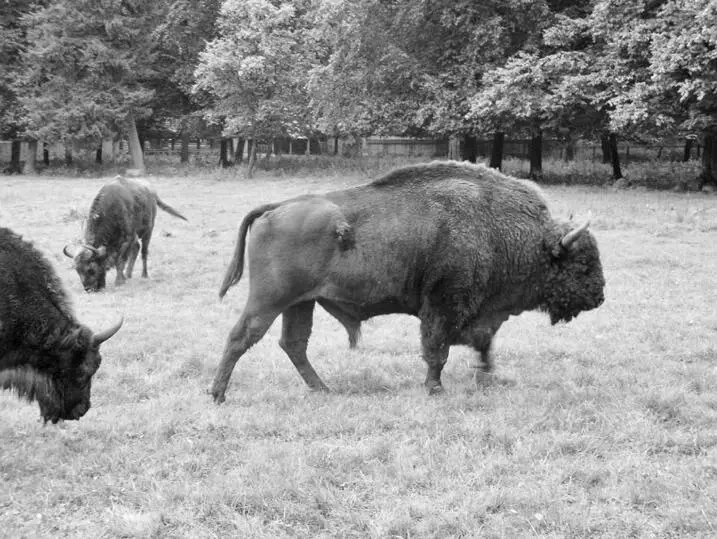The long-term implications of decisions to the national ecology were a constant theme of discussion. Leopold learned of the German appreciation for predators in preventing the degeneration of game, and the status of the wolf as the noble animal of the wilderness. Decades later he claimed this idea for himself. 28However, not all predators and aggressive game were appreciated. A postwar rumour circulated that Göring had a morbid fear of snakes. His senior hunter disclosed this secret to explain Göring’s absence from hunting in wild forests and his preference for high stands. During a visit to Darss, a nature protection park, Göring was shocked and petrified to learn it was the habitat for poisonous Adders. An unnamed forester informed Göring that hedgehogs killed snakes. He immediately called Lutz Heck and ordered 300 hedgehogs brought to Darss. He was persuaded there was no veracity in the story that hedgehogs killed snakes. Göring immediately departed from Darss never to return. 29If Göring had a morbid fear of snakes, it represents an important insight about his fears, but also points to his enthusiasm for eradicating all Jews as vermin.
In 1938 Lutz Heck was promoted chief of nature protection and natural monuments within the RFA. 30He set about a building programme of national parks and game reservations. Heck wanted the people to observe native animals and the habitat to comprehend how the Nazi culture social Darwinism functioned to the greater benefit of German society. Mass public education through micro-models of game habitats was conceived as a means to concentrate the people’s ‘organic gaze’ on the biological values of everyday existence. These early forms of bio-zone were predicted to elevate social Darwinism as the normal natural order of life. Heck believed he was fulfilling the national will because Hitler’s genius was his understanding of nature and its centrality to nation-building. The national parks were put to service in the Nazis’ policies for national recovery. 31The ambition to restore the Germanic game was the mirror of the Aryan being. The Aryan man and Germanic game co-existed in the timeless myth of antiquity. Heck’s ambitions were not limited to Göring, he accepted honorary membership to the SS (June 1933) unusually before joining the Nazi Party (May 1937). He served Himmler’s SS-Ahnenerbe (society for Ancestral heritage) founded in 1935. This SS institute advanced research into racial theories and championed Aryan primacy. Among this group of Nazis, the plans for Białowieźa were conceived.
The ideological lynchpin necessary to complete Göring’s corporatism and institutionalisation was some form of honour code. In 1936 Scherping, under Göring’s orders, instructed Walter Frevert (1897–1962) a state forester and hunter, to write a book about Nazi-German hunting customs. The Jagdliches Brauchtum (1936) drowned the reader in völkisch claptrap but proved to be an instant political and public success. Scherping’s foreword to the book was opaque, ‘The German people are grateful to the Führer for restoring and awakening old and beautiful customs.’ The success of the book led to Frevert’s elevation to Göring’s inner circle and later as a Leibjäger, a personal hunter and confidante, an important position in the hunt hierarchy. Frevert was born in Hamm (Westphalia), his father was a dentist; but, after a distinguished war record as a young volunteer, and a period in the Freikorps, he chose to become a state forester specialising in the hunt. His first forestry rank was Forstassessor and was promoted in 1928 to Forstmeister while serving in Battenberg. Frevert had joined veterans’ associations but in May 1933 became a member of the Nazi Party, and in the summer joined the SA. Frevert’s Nazi membership initially looked like career opportunism, but his subsequent behaviour singled him out as a racist zealot. 32
The Jagdliches Brauchtum was an orchestrated departure from the traditions set down by Ferdinand von Raesfeld in 1914. Frevert dispensed with historical accuracy, ignored quips about pompous hunters, and revelled in any applicable German sources. He adapted a poem by Ernest de Bunsen (1819–1903) to express his sentimentality of the hunt: ‘The origin of the hunter is in the long past close to paradise. There were no trade people, no soldiers, no doctors, no priests, no lawyers but there were already hunters.’ 33However, a serious shortfall in sources about German hunt customs and even fewer German methods led him to invent material for his book. The final version of Jagdliches Brauchtum was a Nazi fantasy composed of made-up stories, plagiarised ideas and foreign rituals. He confessed his reasons were for a good cause, but nobody cared because the book met the approval of all things völkisch prevailing at the time. 34
The climax of the inventions was the Bruchzeichen, a centrepiece of ritual and a ceremony of ‘breaking’ the dead game. Once the animal was killed and retrieved, the Bruch was started. The ceremony opened with a tune from a hunting horn to the dead animal. The hunter then placed a sprig in the animal’s mouth representing its Letzter Bissen (the last meal). The sprigs were taken from oak, spruce, fir, alder or pine trees. The hunter then placed a sprig over the beast’s heart and another covering its nether regions. The hunter’s companion then dipped a sprig of leaves into the animal’s blood, drew his dagger with his left hand, placed the sprig on the blade, and presented it to the hunter. The hunter then took the sprig with his left hand, uttered the words Weidmann’s Dank (the hunter’s thanks), and fixed the blood-soaked sprig to the left side of his hat. If a bloodhound had participated in the kill, it also received a twig placed in its collar. Once the first part of the ceremony was completed the hunter opened up the carcass and removed the entrails.

Image 1: left to right, Oberforstmeister Walter Frevert Rominten, Göring in his capacity as Reichsjägermeister and Oberstjägermeister Ulrich Scherping.
Source: Bundesarchiv, Bild 146-1979-145-13A / CC-BY-SA 3.0

Image 2: Senior Luftwaffe and state foresters in the lounge area in Rominten. A painting of a European Bison is hung on the far wall.
Source: Bundesarchiv, Bild 146-1979-144-15A / CC-BY-SA 3.0

Image 3: European Bison in Białowieźa.
Source: Author, 2009.
Once completed, the hunter began the Totenwacht (guard the dead), an hour-long vigil over the carcass. During this hour the hunter was expected to reflect on the sublime kill and recall past hunts with all their joys and miseries. The carcass was then included in the total tally for the final rituals. The dead carcasses were arranged in order of nobility, size, and by rank, like soldiers on a parade ground. If it was a large tally, braziers and flaming torches were added to the ambience of the moment. The results of the day’s hunt were then read aloud. The horns sounded several more tunes, announcing the end of the hunt at which point the hunters and their guests would raise their right arms in the Hitler Gruss (Nazi salute). Then followed the final horn sounding the Halali (tally-ho). After the ceremonies were over the hunters retired to the dining room to partake in the Tot-trinken (toast to the kill). The antlers were placed on tables, with candles and more sprigs added for decoration. Dinner was then served by silver service. 35
Читать дальше















